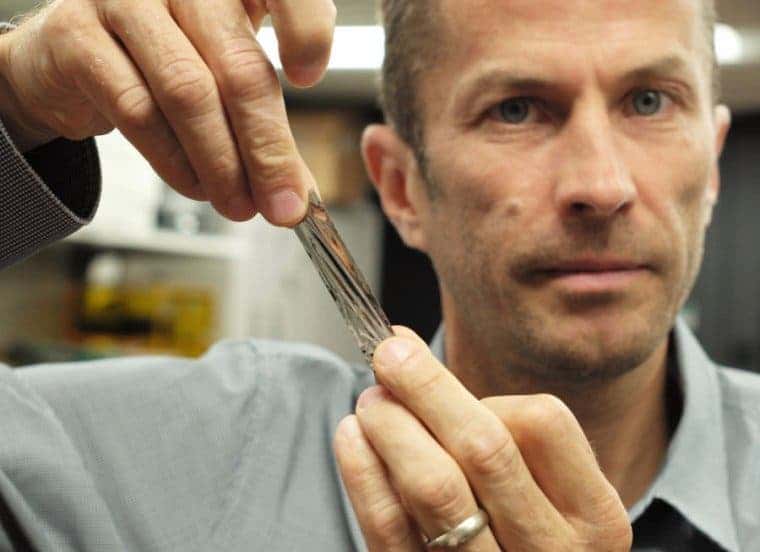
A new kind of flow battery can store energy in organic molecules dissolved in neutral pH water, unlike previous models that required expensive and corrosive electrolytes. Strikingly, tests suggest this flow battery might have an incredible lifetime losing only one percent of its capacity per 1,000 cycles. In contrast, a typical commercially available lithium-ion battery — the kind fitted inside your phone or notebook — doesn’t last for more than 1,000 cycles or two years operation.
It could make stored wind or solar competitive with energy from conventional power plants
A flow battery is very similar in construction to a fuel cell – an electrochemical cell where a dissolved electrolyte solution reversibly converts electrical energy – with the key distinction that the ionic solution is stored outside of the cell, and can be fed into the cell to generate electricity. This is of great interest to engineers since it solves the combined power capacity issue in traditional batteries.
This solution is stored in a tank — the bigger the tank, the greater the battery’s capacity. Immediately, this sounds like a fantastic opportunity to solve the storage issue of large-scale renewable energy power. However, deployment is limited because flow batteries typically employ aggressive electrolytes that degrade the battery after a while and thus reduce storage performance. Periodic maintenance is required and replacing the electrolyte is not cost effective.
Researchers from the Harvard John A. Paulson School of Engineering and Applied Sciences (SEAS) have devised a flow battery that can not only last a long time but requires minimal upkeep as well.
Because we were able to dissolve the electrolytes in neutral water, this is a long-lasting battery that you could put in your basement,” said lead author Roy Gordon, the Thomas Dudley Cabot Professor of Chemistry and Professor of Materials Science.
“If it spilled on the floor, it wouldn’t eat the concrete and since the medium is noncorrosive, you can use cheaper materials to build the components of the batteries, like the tanks and pumps.”
Until now, flow batteries relied on chemicals that are expensive and difficult to maintain, like vanadium, or/and rare, noble metal electrocatalysts like platinum. But because the electrolytes are water soluble, the flow battery developed at Harvard is able to work with alternative chemicals.
First, the team had to identify why previously chemicals would degrade when left in a neutral solution. Through some molecular modeling and good ol’ fashion trial and error, Eugen Beh, a postdoc and first author of the new paper published in ACS Energy Letters, was able to understand why the molecule viologen was degrading in the negative electrolyte. It was then a matter of modifying its molecular structure to make the molecule more resilient in the aqueous neutral pH solution.
[ALSO SEE] What are batteries — everything you need to know
For the positive electrolyte, a similar approach was used. Thanks to its electrochemical properties, ferrocene can act like a fantastic positive electrolyte. The downside, however, is that it’s not natively soluble in the water.
“Ferrocene is great for storing charge but is completely insoluble in water,” said Beh. “It has been used in other batteries with organic solvents, which are flammable and expensive.”
Just like with the viologen, the researchers were able to modify ferrocene’s structure to turn it into a water-highly soluble electrolyte that could also be cycled stably.
Besides reducing upkeep costs, the new design also makes expensive ion-selective membranes redundant. These are essential for separating the electrolytes and because the membrane needs to withstand the aggressive chemistry inside the cell, it can be very expensive — up to one-third of the flow battery’s cost. Because the new design essentially uses salt water on both electrolytic sides, the expensive polymer membrane can be replaced with a cheap hydrocarbon variety.
These batteries aren’t meant to fit in your mobile, though. You’d literally need an external tank filled with liquids and that simply wouldn’t work for a mobile phone. They’re intended for large-scale energy storage, backing power generating plants and making the grid more resilient. Where they shine, however, is in their potential to change how we use renewable energy. One of the Department of Energy’s (DOE) goals is to have a battery that can store energy for less than $100 per kilowatt-hour. At this price tag, stored wind and solar energy become competitive on the market with energy produced by conventional baseload power plants.
“If you can get anywhere near this cost target then you change the world,” said Michael Aziz, the Gene and Tracy Sykes Professor of Materials and Energy Technologies and Roy Gordon. “It becomes cost effective to put batteries in so many places. This research puts us one step closer to reaching that target.”
“This work on aqueous soluble organic electrolytes is of high significance in pointing the way towards future batteries with vastly improved cycle life and considerably lower cost,” said Imre Gyuk, Director of Energy Storage Research at the Office of Electricity of the DOE. “I expect that efficient, long duration flow batteries will become standard as part of the infrastructure of the electric grid.”






